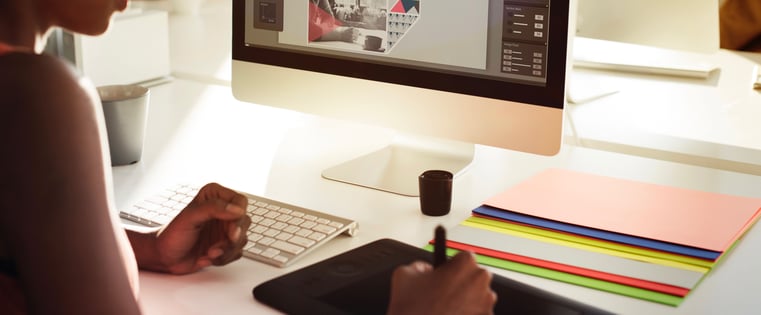
For many of us, the thought of high school conjures memories of ample notebook doodles. Hand-drawn bubble letters, pictograms, and stick-figures would decorate homework, tests, and papers — and teachers, of course, were constantly asking us to knock it off.
And so, most of us did, perhaps because we figured out that we just weren’t that good at drawing on paper. But when some of us were in high school, we didn’t yet have the numerous digital options for “drawing” our ideas. But now, machines can help us bring them to life — and it’s become a career path for many people.
Graphic design is something that marketers can always benefit from learning, even without a formal education. In those cases, we enter a world of do-it-yourself education, with repeated recommendations like, “learn Photoshop, Illustrator, and InDesign,” or, “read a book about basic design principles.” And as much as those help, learning fundamentals, navigating new tools, and developing a personal style make for a tricky balancing act. 
That’s why we put together this list of tips that we wish we had received at the onset of our respective DIY graphic design journeys, along with some tools that can help you with them.
8 Tips for Learning Graphic Design
1) Always keep an ear to the ground.
As marketers, we already know how much there is to learn from influencers. After all, 49% of folks trust the people they know above anyone else for product or service recommendations, and in the digital age, that includes influencers.
Influencers — who according to NeoReach are “individual[s] with an online presence who … influence the opinions and behaviors of your target audience” — are often willing to share the secrets to their success in their content. If you make a point to listen to and engage with them, you’ll become more familiar with the online design world, which can help you discover more tips from other industry experts, become comfortable with relevant terminology, and stay on top of trends.
Wondering how to engage? Turn to Twitter or Instagram as a place to start conversations with these influencers. You never know who might respond to your questions — and any positive connection you make can only help you learn more. Following along and joining the exchange can naturally lead you to become a part of a design community that will support you throughout your journey.
What to Do Right Now
Create a targeted list of influential designers on Twitter, so you can follow their daily insights without having to pick out their tweets from a sea of friends, coworkers, and news sources. You can use the Social Monitoring tool in your HubSpot software to do this by following the people on this list, specifically as they discuss topics that matter to you.
Add a variety of influencers to this list — a mix of those who are well-known among most designers, those that personally inspire you, and those whose work you do not enjoy. That last point may seem counterintuitive, but consistently observing the work of that group can help you understand why you don’t like it, which is a key part of understanding design.
If you’re not sure how to discover designers to follow, try 365 Awesome Designers, which features the work of one designer each day.
2) Collect inspirational work.
Once you decide to learn design, start building a catalog of work you think is successful. That can be as simple as bookmarking images in your web browser, making a Pinterest board, or saving items to a folder on your computer. Like a list of influencers, a catalog of inspiring work will help you to identify trends — both past and present — in design as you begin to recognize patterns in the work of others. You’ll also start to understand your own personal style preferences and interests. If you find yourself continually saving infographics, for example, you might start looking into specific resources to learn how to create them.
Your catalog will also serve to inspire designs you create in the future, which is underscored by the idea that “all creative work builds on what came before” — a line from Austin Kleon’s TEDx talk. If you can reference items in your catalog quickly, you’ll be better equipped to begin your own projects.
What to Do Right Now
Get acquainted with leading designer portfolio sites like Dribbble and Behance. These platforms showcase an abundance of high-quality work from leading designers across the spectrum — everyone from web and UX designers, to graphic designers and typographers. The designers on these sites often provide insight into their design processes, which will be key as you start your own creations.
Setting aside time in your day to review these sites might be hard on top of your workload. One way to naturally work it into your day is to use the app Panda, which replaces your “New Tab” in Chrome with an aggregated stream of content from various sources, including Dribbble. Each time you open a new tab, you can discover and save something that catches your eye. Fair warning, though: An application like this might be distracting to some.
3) Dissect the process.
One of the most pivotal moments in my design journey was when I recognized that every single illustration, infographic, and icon I had ever ogled over was the product of someone mastering how to combine shapes and lines. That’s not to say that other factors don’t play a role — just wait until you try and learn meshes in Illustrator — but fundamentally, these designs were built up from simple shapes.
Analyzing the process behind a design will allow you to understand the steps required to produce a piece of work. Depending on your current skill level, you may have a leg up in knowing which tools were used, or which aspect was created first. But don’t let that stop you — examining the construction of a design will let you flex your creative muscle. Educated guesses will do far more to teach you than doing nothing at all. Plus, you’ll likely find that:
- You know more than you think you do.
- When you identify holes in that knowledge, you’ll know what techniques or concepts you need to explore to narrow the gap.
- There’s more than one way to achieve a desired result.
What to Do Right Now
A quick way to expedite the learning curve when dissecting a design is to download a free vector or PSD design resource, and dig through the layers to see how the designer constructed the object — you can find a number of those files here.
Once you pick your file, open it in Photoshop, then open the Layers Panel (which you can learn to use here) and un-collapse some of the folders, so that you can see the layers contained within them.
By simply changing the visibility of the layers, you can begin to see how the designer used each shape to build upon one another. You can also begin to understand how to use Photoshop Effects, like drop shadows and strokes.
4) Get specific with your online search queries.
As you begin creating your own designs, you’ll likely hit an obstacle where you think to yourself, “Hmm. How the heck do I do that?” Chances are, others have wondered the same thing. Like many self-taught disciplines these days, the majority of my own technical design knowledge was gained by watching a YouTube tutorial while I actively followed along.
The key is to be really specific with your searches, so you can find a highly relevant tutorial. Searching for something like “how to create an icon” might deliver really broad search results. Instead, type in exactly what you want to learn, like, “how to create a flat icon with a long shadow.” Boom.

What to Do Right Now
Browse a design terminology glossary to find the specific terms for techniques you’re trying to learn. That can help you find what you’re looking for online much more easily, in addition to helping you familiarize yourself with the language.
5) Reproduce your favorite work.
Let me be clear: Under no circumstances should you infringe on anyone’s copyrighted work. Never reproduce someone else’s work and try to pass it off as your own.
That said, re-creating a design you like — without advertising it as your own work — will help you gain a deeper understanding of design technique. As with dissecting a design, it’ll help you learn new technical skills that’ll come in handy when you’re creating your own designs.
You’ll have to get creative with the method you choose to recreate the design, so this exercise will utilize both the left and right sides of your brain. Don’t get frustrated if you can’t duplicate a design exactly — remember, the process is more important than the result.
What to Do Right Now
Find a design piece you think is successful — which should be easy if you’ve created an inspiration catalog — and use your preferred piece of software to recreate it, whether that’s Photoshop, Illustrator, or another software. It’s really up to you to choose how you go about actually creating it. Use specific search queries and tap into your design community relationships as resources.
6) Embrace negative space.
 Source: Apptension
Source: Apptension
The proper use of negative space is often overlooked by beginner and advanced designers alike. What is negative space (or “white space”)? It’s the space in your design that’s not occupied by any visual or written element. A design piece that doesn’t incorporate enough negative space is like a sentence with no spaces – itisdifficulttocomprehend.
Jan Tischold, one the most influential typographers in history, stresses this importance: “White space is to be regarded as an active element, not a passive background.” The effective use of negative space is just as crucial as the design itself. Don’t believe me? It’s scientifically proven that white space improves legibility and comprehension.
What to Do Right Now
Learning to effectively use white space won’t happen overnight. You’ll have to try out different options to find what works for each design. First, I’d recommend reading some of the articles on this list, compiled by David Kadavy, author of Design for Hackers: Reverse Engineering Beauty. Then, try to put some of these theories into action.
Remember, there’s no hard-and-fast rule to using white space. It takes practice. Eventually, you’ll find that exercises in resizing elements of your composition and changing the layout will lead to a natural understanding of the amount of breathing room required.
7) Don’t be afraid to get feedback.
On some level, everyone is afraid of criticism. We’re afraid our ideas will get shot down and we’ll be sent back to square one. Learning to accept constructive criticism is no easy task, but it’s key to becoming a better designer.
Paul Arden, who was the creative force behind Saatchi & Saatchi at a pinnacle of its success, wrote this in his best-selling book, It’s Not How Good You Are, It’s How Good You Want to Be:
If, instead of seeking approval, you ask, ‘What’s wrong with it? How can I make it better?’, you are more likely to get a truthful, critical answer. You may even get an improvement on your idea. And you are still in a position to reject the criticism if you think it is wrong. Can you find fault with this?”
The takeaway: Design critics allow us to incorporate others’ viewpoints into our work and improve upon our ideas. You always have the option to reject the feedback — but considering it in the first place is what’s important. Design is subjective in nature, and just because someone else has a different opinion doesn’t mean you’re wrong. In fact, trusting your intuition is equally important. Just make sure you have the means to back up your design decisions.
What to Do Right Now
The best way to get feedback is to have a one-on-one conversation with an experienced designer. If you don’t know anyone in the design world, that can be difficult. Fortunately, the internet is filled with communities of designers eager to give feedback — that’s why we suggested finding influencers and peers to engage with.
If you haven’t had time to become a part of a community, now’s the time to step outside of your comfort zone and take action. Inbound.org offers a great feedback center where viewers can comment directly on your design. Other great forums include The Crit Prit, and Reddit’s Design Critiques.
8) Pick a passion project.
If you only listen to one piece of advice from this post, let it be this one.
We all know how hard it is to work on something you don’t want to. It just plain sucks. Picking a project that you aren’t passionate about will likely lead to frustration, as you’ll likely feel reluctant to devote the time and effort necessary to complete the project. And you would be remiss to ignore the fact that, at some point in your career, you’ll have to design something you may feel less than thrilled about.
But that likely won’t occur until you’ve learned a thing or two and have advanced your design skills. In the beginning, it’s OK to focus on passion projects.
When you’re taking the time to teach yourself graphic design and the consequences — like money lost on a wasted design class — are minimal, passion is a major motivator. When you pick something you care about, you’ll compel yourself to work through the frustration that comes with the sometimes tedious nature of design.
It’ll also provide direction. Time and time again, the hardest part of learning design is not knowing what to design. Be decisive and choose something you can work on for a length of time.
What to Do Right Now
Align your interests or current situation with your projects. If you’re a blogger, try creating the header image for your next post. Voice your willingness to work on an offer with your content team. Looking for a job? Redesign your resume and try to further your personal brand by creating a logo. There’s a number of ways to work design into your day, but it’s up to you to pick something that matters to you — don’t design something simply because you think you should.
And Above All
It’s important just to get started. It’s easy to be intimidated by the sheer amount of learning associated with graphic design, but remind yourself that even the most talented designers were newbies once, too.
What makes the creative field so special is that everyone’s journey is unique — there’s no one way to approach DIY design. You’ll find your own means to discern what you want and need to learn.
Design is an iterative process, so keep reworking your ideas and projects. As you progress, you’ll develop your own workflow and one day that design that took you all day will only take you an hour. Trust me, I’m living proof.
What other tips do you have for self-taught designers? Let us know in the comments.
Powered by WPeMatico







